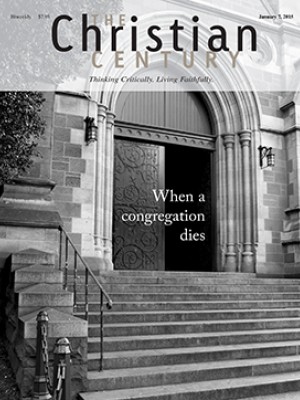Final gifts: How institutions can die well

The numerical decline in churches, the graying of the mainline, and the growth of the nones (people who claim no religious affiliation) have generated lots of talk about institutional death. The activities of death and decline in the church happen quietly: endowments atrophy, sanctuaries are deconsecrated, and church bodies strain to make the membership losses seem less obvious.
In almost every conversation I have about this phenomenon—especially with ecclesial leaders—the idea of institutional crisis and renewal comes up. A common theme is that crisis—the threat of death—presents an opportunity for renewal. The language of crisis and renewal (borrowed from the world of business management) is paired with the theological categories of death and resurrection. The church needs to experience a death in order to experience a resurrection, the argument goes.
Read our latest issue or browse back issues.
For example, Presiding Bishop Katharine Jefferts Schori said this in September to the Episcopal Church’s House of Bishops: “This Episcopal Church is in the throes of creative ferment, yearning to find a new congruence that will discover emerging life in new soil and refreshed growth in the plantings of former years.”
The signs of institutional decline are seen as laced with promises of new life. Didn’t Lazarus have to enter into the tomb in order to be resuscitated? It’s comforting to think that death might be the very thing to bring a church or institution back to life.
But talk of resurrection in this context may be a way of denying death, a way to stuff our ears with eschatological cotton balls, refusing to think about where we are and who we are. The resurrection—God’s undoing of death—is not a church growth strategy. This easy invocation of the resurrection can be a way to disregard or avoid the hard work of preparing for death. We want a resurrection without the dying.
When you ask individuals how they want to die, many say they want it to be quick, preferably as they sleep. But many deaths involve a slow decline, punctuated by aggressive and costly procedures enveloped in an atmosphere of fear.
Surgeon and author Atul Gawande, in his 2010 New Yorker article “Letting Go,” describes the fraught relationship the dying have with technology: “Technology sustains our organs until we are well past the point of awareness and coherence. Besides, how do you attend to the thoughts and concerns of the dying when medicine has made it almost impossible to be sure who the dying even are? Is someone with terminal cancer, dementia, incurable congestive heart failure dying, exactly?”
This description could easily apply to segments of the North American church. Institutional deaths mirror our individual deaths in being expensive, drawn out, and full of fear.
Institutions need to think and talk about how to die well. Often, both individually and institutionally, we are, as Gawande says, “unprepared for the final stage.” This lack of preparation leads to either an abrupt ending or what some have called institutional zombification.
Minister and activist Will D. Campbell once held a funeral for a town—Golden Pond, Kentucky. It was an odd act but showed how the practices of death and dying are for more than individuals.
So how do institutions die well? Author Andy Crouch says that “one of the mistakes institutions make is to defer facing their failure to the point that they have no more resources to attend to the end. They just collapse rather than exit.”
Surviving is not synonymous with faithfulness, and death is not failure—unfaithfulness is. If the church is to start thinking about what a good death looks like, it should draw from the wisdom and practices of those who provide hospitality and care to those closest to death: those who work in hospice.
Gawande reports on the work of a hospice nurse, who tells him that “the difference between standard medical care and hospice is not the difference between treating and doing nothing. . . . The difference was in your priorities. In ordinary medicine, the goal is to extend life. We’ll sacrifice the quality of your existence now—by performing surgery, providing chemotherapy, putting you in intensive care—for the chance of gaining time later. Hospice deploys nurses, doctors, and social workers to help people with a fatal illness have the fullest possible lives right now.”
Generally, hospitals aim for cures, and hospices aim for care. However, there is no cure for mortality. Hospice recognizes that there are times when certain procedures should not be performed and that a good end of life sometimes means that not everything that can be done to extend biological life is done. As Stanley Hauerwas says, “You don’t have to do everything necessary to keep your body alive.”
The same insight applies to institutions. Churches may spend time and resources bringing in outside speakers and consultants, going to conferences, purging the bureaucracy, targeting one interest-based group after another, building drum cages, buying nicer coffee, and importing a pastiche of practices and ideas from other industries and communities. These are not inherently wrongheaded activities, but they may detract or deflect from real end-of-life flourishing. Flourishing at the end of an institution’s life involves asking different questions: What should we grieve? How do we celebrate our work? How do we give faithful and final gifts with our resources to those around us? Instead of seeking simply to extend life, institutions should concentrate on the laments, the joys, and the giving of gifts.
The second lesson hospice teaches is that the work of dying isn’t done alone. A good death takes a team, or better yet, a community. Institutions should die in dialogue and relationship with other institutions. Dying well involves knowing the needs that surround you, the opportunities (and risks) that your resources present, and the legal and financial regulations that surround an institutional shuttering.
Christians have done a lot of thinking about what good and holy deaths look like in their remembrance of martyrs. The death of the martyr bears witness to Christ, typically in the face of persecution. (However, concepts of self-martyrdom were present in the asceticism of individuals like the third-century monk Anthony.) Institutions that are dying may not face persecution, but they can learn from the tradition of martyrdom that it is possible to lay down one’s life for Christ. As Rowan Williams says, “Martyrdom affirms that there is something worth dying for, and it is the grace, the love, the infinite compassion of God. . . . Martyrdom is one form of Christian ‘excess.’”
A good institutional death may look like a kenotic martyrdom. It involves the institution giving itself away—an excessive self-emptying.
Last summer, Tony Campolo’s ministry, the Evangelical Association for the Promotion of Education, closed its doors. The EAPE existed to nurture organizations that combined a concern for evangelism and social justice in working with impoverished communities. In an interview with the online magazine Faith & Leadership, Campolo said: “The ability to scale down is important. How many organizations exist when their reason to exist and their ability to get the job done have long since come to an end? . . . As though there is something ungodly about saying, ‘It’s time to stop.’”
Campolo forced EAPE to ask tough questions, eventually leading it to consider how to close down thoughtfully. The process took over a year, with legal proceedings and meetings and attention to numerous details. Eventually EAPE gave its resources to some of the ministries it had helped found, and it asked its donor base to direct support and money to these other ministries.
EAPE didn’t fail, or collapse, or lumber along looking for new resources to consume. EAPE exited. And it ceased to exist by thoughtfully and slowly dialoguing with others and passing parts of its life on to them.
Crouch comments, “Stewards of an institution in the hospice phase need to ask, ‘How do we send out the image bearers who have found dignity, agency, authority, and vulnerability in this institution to join other settings where they can flourish?’ There is a responsibility to not just throw people out, but to ask what is transferable from this institution to others?”
Institutional deaths should be slow, but slow for the right reasons. EAPE’s death was slow not because it spent everything—people, time, money, and places—for the sake of survival. It was slow because it spent time identifying the needs of fellow institutions and carefully directing its resources to them.
For an institution, kenotic martyrdom involves more than giving away resources and wisdom. It also involves the dual act of public repentance and joyful celebration. Every church, school, denomination, or nonprofit has wounded others. Dietrich Bonhoeffer’s theological equation in Life Together, “Confession is discipleship,” holds true for institutions at the end of their lives.
Repentance of institutional sins requires the truthful exercise of memory. While the capacity for truthful memory escapes many institutions during their lifetime, perhaps an impending death can provide the opportunity for it. A good death means that institutions take responsibility for past (and current) wrongs, publicly naming them, and asking for forgiveness.
Public confession and repentance are possible only if an institution enters into its demise thoughtfully, reflecting on its history and how it has interacted with others. Confession paves the way for the institution to remember and gratefully celebrate its ministry. This gratitude should point to and proclaim Christ, recognizing the grace that allowed the community to participate in God’s redemption of all things.
God’s gifts to us are not “fully realized until they are given away,” writes Lewis Hyde in The Gift: Creativity and the Artist in the Modern World. Just as Christ reveals that there is something worth living for, he also reveals that there is something worth dying for. Institutions can die for the larger church, for Christ, for the mission of God, and for the flourishing of others. When it comes to institutional death, the holiness is in the how. A good death is an act of worship. A good death teaches other institutions how to die. A good death can be faithful.
A church’s kenotic martyrdom bears witness to how the church (or any institution) is not synonymous with Christ. It bears witness to how death is not the final word. Good deaths do not deny death, but point to death’s undoing. Christ lives even amidst and after our individual and institutional deaths. Humanity has more to it than bodily life. There is more to God’s kingdom than us.
Clinging to life is not the same as living. At the end of their life, institutions should begin the slow and thoughtful process of public repentance, joyfully remembering their ministry, pointing to Christ, sharing their wisdom, and giving away their gifts. Oddly enough, a good death sounds a lot like a good life.






